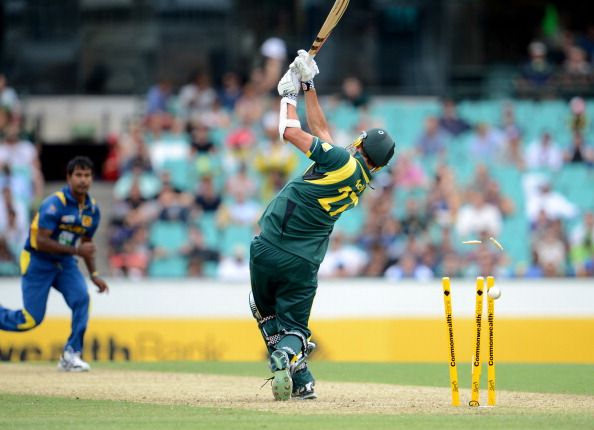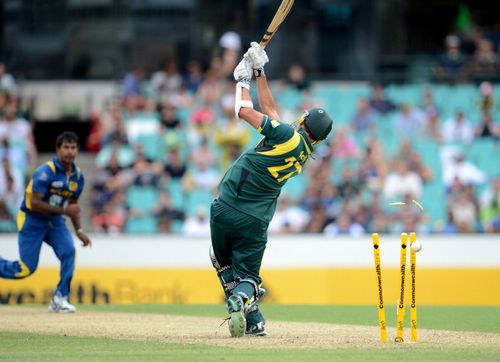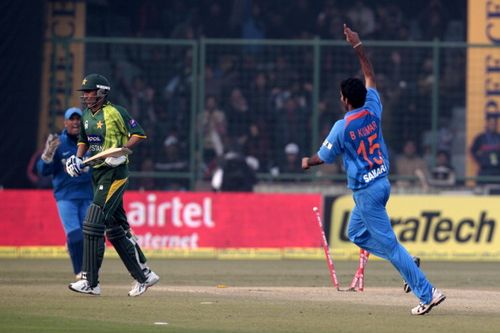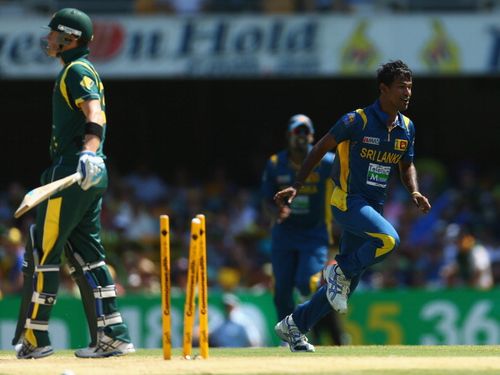
Square seamers - It's not just about the pace

In this fast pace of cricket world, the likes of Dale Steyn, Steve Finn, Umar Gul and Lasith Malinga are supposedly the real ambassadors of seam bowling. They usually clock mid 140s or more, generate raw speeds to beat the batsman’s willow and operate at great lines and lengths. It shouldn’t be too much of a surprise if you see their high wicket tallies too often. They are taken for runs at times, but as long as they keep on picking up wickets, it’s a fair gamble.
Then there are the specialist death bowlers who operate with bags of exotic tricks such as sending down a slow loopy bouncer, bowling it wide of off stump, thrusting a yorker right into the block hole and cramping batsmen of some room. The likes of Stuart Broad, Jacob Oram, Jade Dernbach(they say he’s a death bowling specialist) fall under this bracket. You don’t have an impressive wickets column beside their names but the economy rates are usually low.
So, in this world of fast bowling, where you either bowl it fast or use variations(even a mixture of both) to succeed, there stand out two particular pacers bereft of either qualities, who’ve come to the aid of their teams recently – Bhuvneshwar Kumar of India and Nuwan Kulasekara of Sri Lanka. There lie far more striking similarities between both these opening bowlers – both are short, thin, bowl military medium pace, operate at steady lengths and can swing the bowl either way square off the wicket. You normally associate a Muralitharan or a Warne while speaking about turning the ball square off the wicket but such are the angles subtended by the deviations achieved by their deliveries, that they make a mockery of the usual notion. Moreover, they boast of miserly low economy rates and attractive wicket columns.
A small dig into the recent past might prove what impact they had have had on their respective sides.
India had a bizarre cricketing season after their ODI World Cup win in 2011. They lost two Test series to England (one away and one at home) and were white washed in Australia too. They couldn’t make it to the finals of CB series and Asia Cup in 2012 and were knocked out before the semifinals in 2012 T20 World Cup. Their series wins at home against West Indies and New Zealand were quite obvious, given the level of the oppositions. The Pakistan tour of India started with a familiar batting collapse, when India could only post a sub 140 score. A young debutant named Bhuvneshwar Kumar was given the new ball to start the bowling. In the first over itself, he showed so much of promise with his swinging ability by moving the ball both ways and the manner he got his first three wickets – knocking down the stumps after pitching the ball, swinging it back onto the stumps, was a real treat to watch.

A sudden ray of hope was instilled in the Indian side, thanks to the impetus provided by the newcomer. Despite losing that match, India found a new hero in their ranks. From there on, he has only looked forward – picking up wickets and keeping a check on the scoring rate in the mandatory powerplay overs.
The greatest asset for any sportsmen is his/her hunger for success, offering no signs of discomfort. This 22 year old lad has a great knack of picking up wickets. Such is his consistency in line and length that with a clever variation in the swing, it eventually draws the batsmen to make mistakes. He offers no freebies and makes the batsmen work their way out by this disciplined effort. His Captain MSD imposes great faith in this guy and lets him continue his attack against the batsmen by making him bowl his full quota of ten overs in the first half of the match itself. This strong lad has shown great patience and no fatigue in living up to the expectations of his skipper. As any cricketing pundit would suggest, taking early wickets is the key to restricting the opposition. The job has been offered to his skilful hands and as it was evident in the recent Ind-Eng ODI series, he broke the spine of the English batting, exposing the lower order that could hardly carry forward the challenge; the result being a score of 150 for England and an emphatic victory for India. Such is his impact that even the batting failures of a couple of players are going unnoticed. Thus, Bhuvneshwar Kumar is an X-factor in the new and young Indian side.
Across the Gulf of Mannar, we have the cricket playing island-nation of Sri Lanka. There must be very few people whose first name is the same as last name. So is the case with this bowler – Kulasekara Mudiyanselage Dinesh Nuwan Kulasekara. Unlike India, Sri Lanka has always found their share of world class bowlers such as Chaminda Vaas, Muttiah Muralitharan, Lasith Malinga etc. Having made his debut alongside the aforementioned players, Nuwan Kulasekara was always thought of as a bright talent with the ball. His ability to pitch the ball in right areas and swing it both ways is such a rare gift and any captain’s delight. The consistency of his performances led to his mercurial rise to the top of ODI rankings which surprised many but none who have closely followed his play. Despite reaching the finals of the latest ICC ODI WC and ICC T20 WC, Sri Lanka has failed to repeat its performance in bilateral ties. They were comprehensively beaten 4-1 against India in home conditions. During the Australian tour, Sri Lanka suffered another humiliating 3-0 loss, even though it had classy batsmen like Mahela Jayawardene, Kumar Sangakkara, Tillakaratne Dilshan and Angelo Mathews in its ranks. The injury during the first Test had sidelined Kulasekara for the next two Tests. After the first loss in the ODIs against Australia, it all seemed follow a similar script. But thanks to the absence of senior pros in the Aussie side(due to retirement of Mike Hussey, rotation policy and injury to Watson) and in some bowler friendly pitches, Kulasekara and other Lankan bowlers made big breakthroughs and took Sri Lanka to a breathtaking win. Following this spirited performance, Nuwan scripted an absolutely crushing victory for Sri Lanka in the third ODI at Gabba.

He took his maiden five wicket haul in ODIs with a career best figures of 5/22 to rip through the Australian batting attack. His sharp in-swingers to the right handers and the out-swingers to the left handers were too lethal for Aussie batsmen. Such was the deviation in trajectory the ball that he used it to make the batsmen dance to his tunes. He broke through the spine of the Australian middle order and they were left reeling, facing the ignominy of posting their lowest score in ODI history, when a Mitchell Starc-Xavier Doherty last wicket partnership somewhat saved their face. Yet 74 all out was their third lowest score, and lowest in the last 27 years. Even the fourth ODI started on a familiar note, the most significant dismissal being that of in-form Michael Clarke. A sharp in-swinger from Kulasekara breached through Clarke’s defence and knocked the stumps over – it was surely the ball of the match. Eventually a late half-century by Mitchell Starc and a dramatic and controversial abandonment of the match due to unfair playing conditions saved the blushes for the Aussies. It was anti-climax when a batting failure led to a Sri Lanka’s loss that drew the series 2-2, denying the Lankans their first victory on Australian soil. Eventually, Nuwan Kulasekara was deservingly awarded the Man of the Series award.
Indeed, both sportsmen don’t boast of great physique to extract raw pace from, yet their consistent and disciplined approaches enabled them to trouble the batsmen, be among the wickets and gather success. Seam bowling is about consistency and it’s just not about the pace.